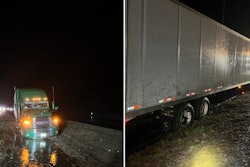
While work has begun to remove the wreckage of the collapse of the Francis Scott Key Bridge blocking the Port of Baltimore, officials say it is still unknown how long it will take to rebuild the bridge and reopen the port to cargo ships. A 200-ton section of the bridge was removed late Sunday.
The bridge collapsed in the early morning hours of March 26 when one of its supports was rammed by the containership Dali, which had lost power while exiting the harbor. Six workers on the bridge at the time died; the bodies of four of them have yet to be recovered.
The Unified Command Sunday said demolition crews continue to cut portions of the north side of the collapsed bridge truss. Two crane barges, a 650-ton crane and a 330-ton crane, are actively working on the scene. A statement from the command said removed wreckage is being transferred to a barge. A 230-ton land-based crane will offload and process the wreckage at Tradepoint Atlantic. Every lifting operation requires engineering analysis to inform salvage operation plans, according to the command.
Three dive teams with the command are surveying sections of the bridge and the Dali for future removal operations.
The command consists of:
- U.S. Coast Guard
- U.S. Army Corps of Engineers
- Maryland Department of the Environment
- Maryland Transportation Authority
- Witt O’Brien’s representing Synergy Marine
- Maryland State Police
Meanwhile, officials say there is no estimate of how long it will take to remove all of the debris, or when the port might be reopened to shipping traffic. Likewise, there is no estimate as to when construction could begin or when a new bridge would be completed. It took five years to build the former Francis Scott Key Bridge.
The port continues to be open for truck transactions.
The State of Maryland declared a state of emergency almost immediately after the bridge collapsed. That triggered an emergency declaration that provides relief from federal hours-of-service requirements in 49 CFR §§ 395.3 and 395.5 for motor carriers and drivers providing direct assistance to emergency relief efforts due to the bridge collapse..
The Federal Motor Carrier Safety Administration the relief applies regardless of the motor carrier or origin of the trip, so long as the carrier or driver are providing direct assistance. Direct assistance includes transportation and other relief services provided by a motor carrier or driver related to the immediate restoration of essential services or essential supplies. The FMCSA said examples of direct assistance include transportation of heavy equipment and personnel into the area and removal of debris to assist state and local emergency efforts reopen the Port of Baltimore and the waterway impacted by the bridge collapse.









